Stockholm,
Sweden
Story
written
by Rick Archer, Sept 2012
Stockholm is a
far-flung city situated on 14 different islands. Marla
wrote extensively about the highlights of this city, so be
sure to check out her
Stockholm piece for more information.
As you can see
from the picture, despite the immense size of the city, the
cruise ship was able to dock right in the middle of
everything. Wherever I went, the ship was always in
convenient sight to reassure me.
My day was
divided into three parts - roof hopping (2), a missed
meeting with Marla (4), and a long walk with Jan Davis and
her lovely daughter Melissa to an island named Skeppsholmen
(5), followed by another long walk back to the ship (1) at
the end of the day.
|
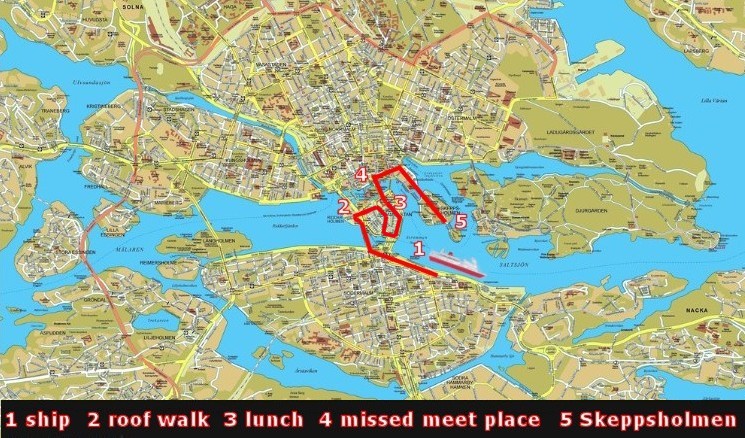 |
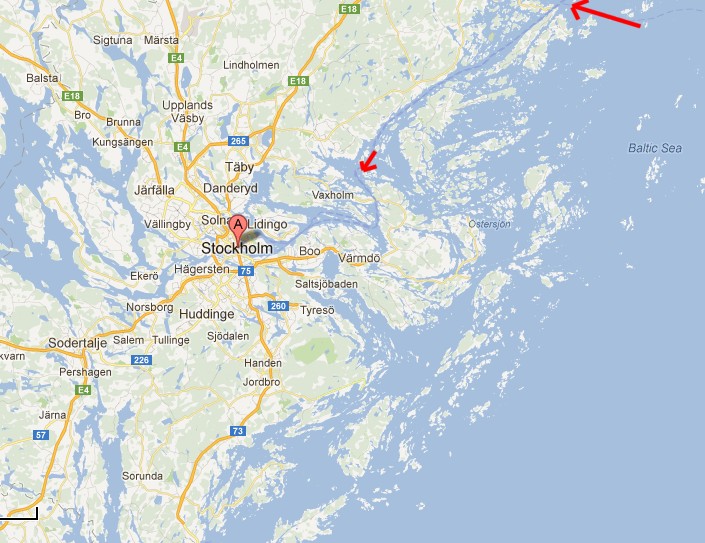 |
Stockholm has a very unique geography. It is surrounded
by a vast network of lakes and rivers.
If you study the map, you will see a faint purple line that serves
as the entrance from the Baltic Sea to Stockholm.
In a manner very similar to Houston, Texas, Stockholm is located 50
miles inland. The big difference is they didn't have to build
a ship channel. Ships have been navigating that route since
time immemorial.
Stockholm is known for its abundant clean water and
many parks. It is sometimes referred to as the "Venice of the
North". I didn't see any gondolas ala Venice, but I got high up and could
see waterways in every direction. This city is not only very
green, it is definitely full of water.
Unlike Russia's St. Petersburg where they had to bring in tons of
dirt to create islands out of swampland, the Swedes were able to use
the 14 existing islands to build their city around the water.
I can attest that the water did appear to be unbelievably clean.
They say the water is safe to fish in and safe to swim in. I
believe that.
|
|
This picture gives a good idea of the complexity of Stockholm's
design.
The water is so wide from shore to shore that you begin to realize
this is not your average "river". Indeed the water you see in this
picture is not a "river" but an actual "bay".
This water area is known as Riddarfjärden Bay, or "Riddar
Fjord" if you prefer.
As the picture suggests, there is a great deal of water to the west.
About ten miles or so to the west of Stockholm there is a gigantic
lake known as Lake Mälaren.
Stockholm is situated on an island cluster or island chain
known as the Lake Mälaren Archipelago.
|
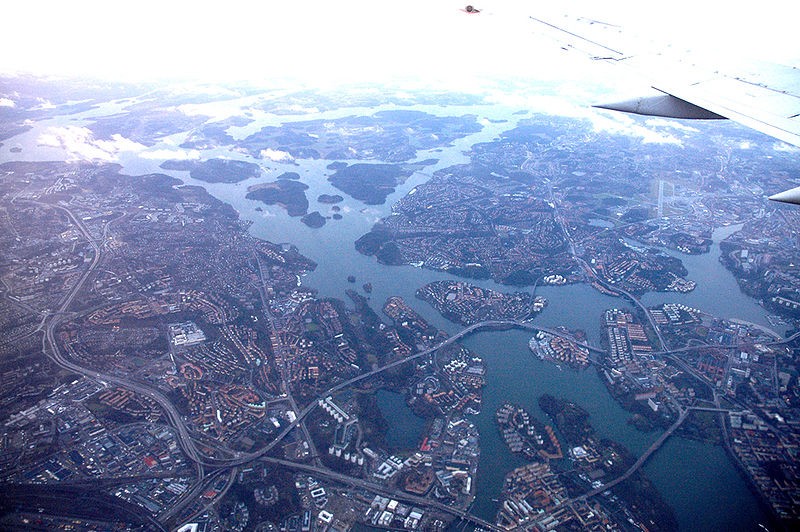 |
|
 |
The Swedish
Coastline
The approach
from the Baltic to Stockholm is very picturesque.
The picture
above shows the river or channel that serves as the approach
to Stockholm from the sea. This area of water was so
wide that it felt more like a lake. Please note there
was another coastline behind me as I took this picture.
We were sailing down the center of the channel.
The rugged
coastline of Sweden is highly reminiscent of Alaska.
There are long undeveloped stretches of land that are
heavily-forested. The wide channel was lined with
little islands everywhere I looked. Very beautiful.
As the ship
got closer to Stockholm, we began to see trophy homes built on
some of the larger islands. What may not
be clear from these pictures is that there is another body of
water right behind the homes. Many of these
islands were only large enough for one, two, or three homes.
Wouldn't it be
fun to live on your own little island?
|
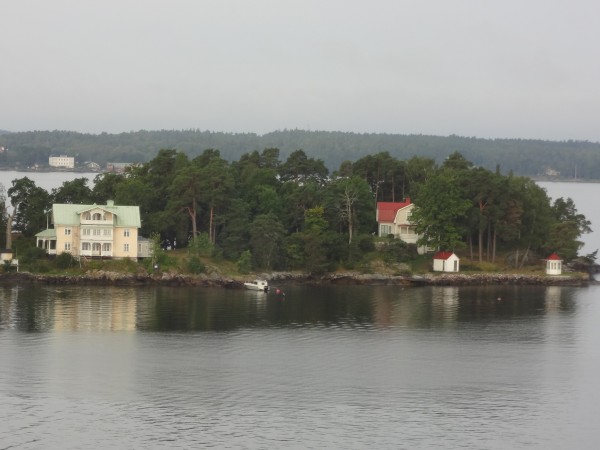 |
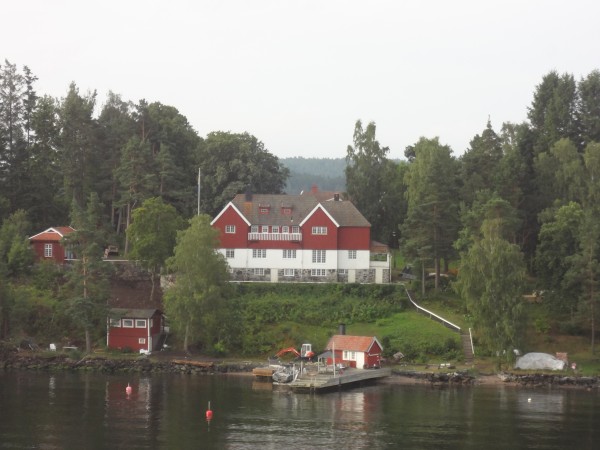 |
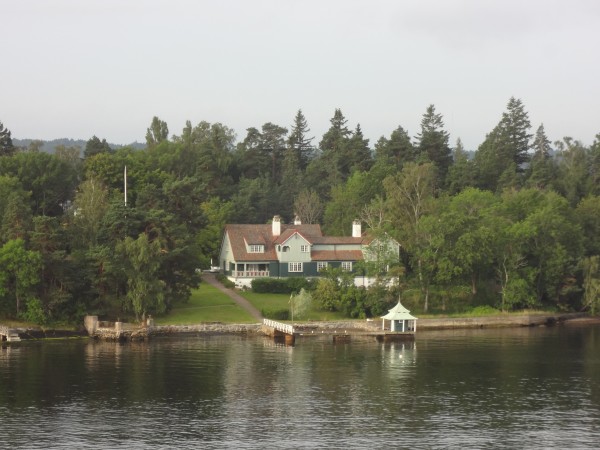 |
| |
|
Roof Hopping
I have known
Jan Davis all the way back to the late Eighties. Jan
was part of our wonderful "Studebaker's Gang". Every
Monday night an entire group of friends would meet at
Studebaker's for Happy Hour. In exchange for buying a
couple drinks, we got a free meal and a chance to dance East
Coast and West Coast Swing to great oldies music from the
50s and 60s.
For sideline
entertainment, we watched in great amusement as Hal
Perry spent the night dodging waitresses. Hal had lost
his job and was trying to save money. Once Hal
realized he could get a good meal at Studebaker's for free,
he would slip in to get a meal when the waitresses weren't
looking. Then he would spend the night running onto
the dance floor anytime a waitress came near to take his
drink order.
One night Hal
even grabbed me. I was the only one around at the time
and Hal panicked as the waitress approached. Once we
were on the floor, I said, "Now what?" Hal
grinned at me and started to freestyle.
Those were the
days, my friends. We thought they'd never end.
|
 |
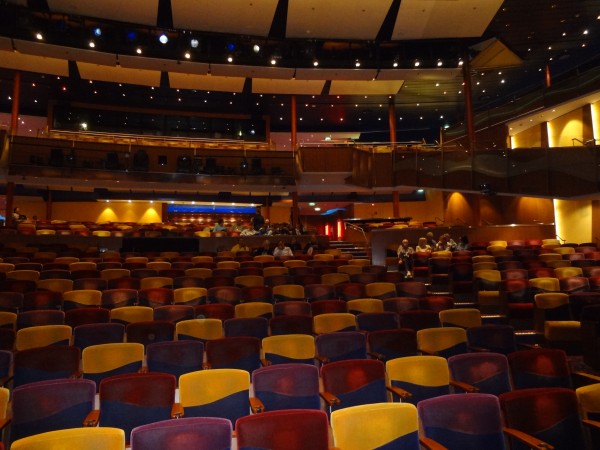
Jan said her
daughter Melissa had talked her into an excursion called
"Roof Hopping". Jan invited me to join them. I
had no idea what "roof hopping" was, but I was curious.
When I looked at the vague writeup, it sounded interesting.
It sounded like "urban zip lining". Sign me up.
|

Marla and
Velma were not interested in risking their lives, so they
signed up for something else. Since both of our
excursions ended around 12:30 pm, Marla and I planned to
meet for lunch in the middle of Stockholm, then walk around
the city. Nice tan, Marla!
|
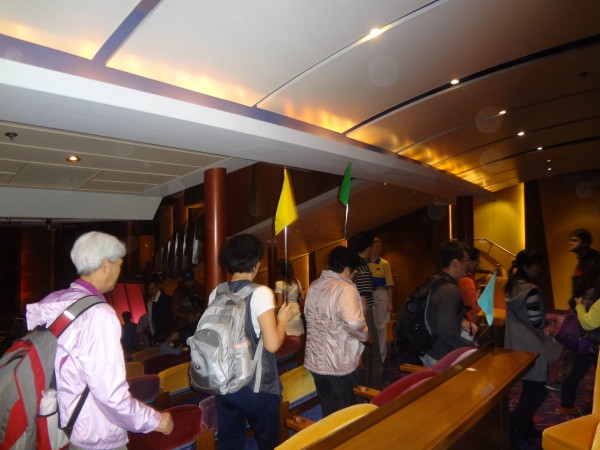 |
 |
Say hi to Eva on the right.
She was our intrepid leader. In addition to keeping us safe,
Eva entertained us with her good
cheer. Her knowledge of Swedish history was so vast
I assumed Eva was a history major.
No, it turns out
she is an actress. Eva said she had a bit part in the movie
Girl with the Dragon Tattoo. Now I know
what moonlighting actresses do... they hop from roof to
roof. I suggested Spiderman as her next movie.
Eva smiled.
My favorite
Eva story revolved around the ancient ritual of public
hangings in Stockholm. These Friday events were so
popular they were attended by huge gatherings.
She said it was not at all uncommon to collect human heads
after death and use them as drinking bowls. This was
derived from the morbid Viking custom of drinking mead or
ale from the skull of a fallen enemy. In fact, Eva
declared, this led to common practice of saying "skoal" as a
drinking toast. Eva added that "skoal" is Swedish for
"skull".
To tell the
truth, I didn't believe her. However Eva insisted she
wasn't making this up. You know me. I had to
check it out. Wikipedia said this is an urban legend.
Too bad. I liked that story.
|
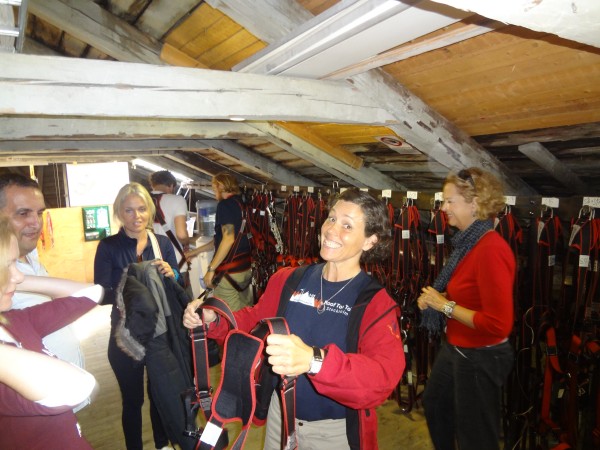 |
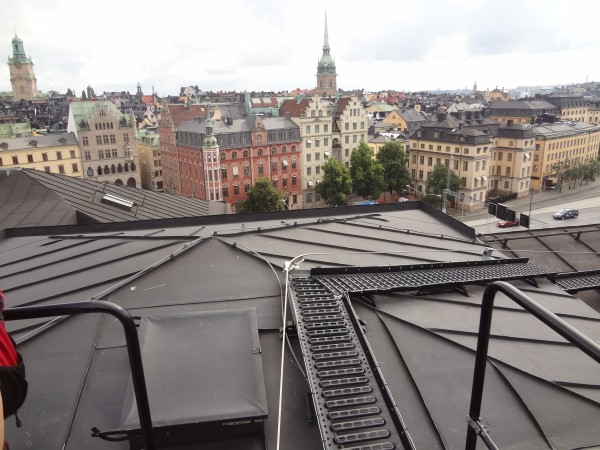
So what
exactly is "Roof Hopping"? Based on the quite vague
explanation in the excursion book, I visualized that we
would walk across a roof, then take a zip-line ride to
another roof. That would have been cool.
As it turned out, there was no roof hopping at all. We
stayed on one roof.
|
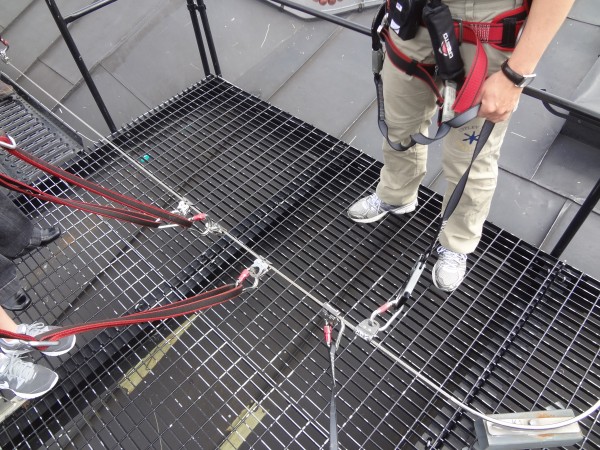
The actual activity was far less exciting. They tethered
us to a steel cable and let us walk around on the metal path.
Since there weren't any handholds in some places, it was
possible that
someone could lose their balance and slip. If this
happened, the tether would keep the person from sliding over the
edge. |
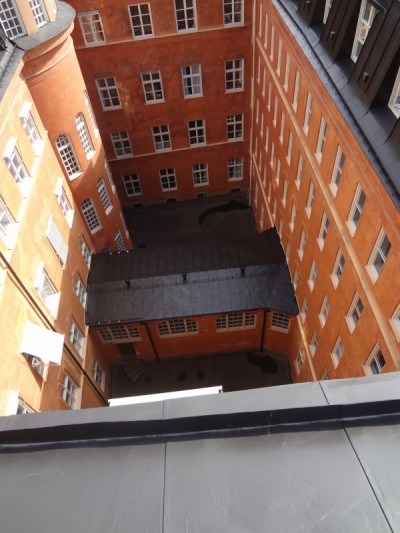
Don't get me
wrong. There was an element of danger. After
all, the drop was definitely significant. However, in
my opinion, the tethers removed all possible risk.
|
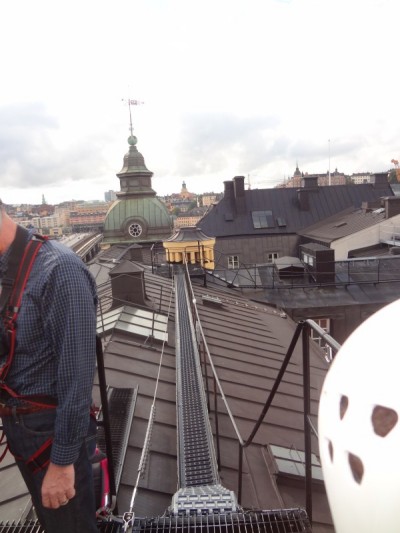
Too bad.
I was really looking forward to zip-lining from house top to
house top like a modern-day Urban Tarzan. As a boy, I
used to practice my Tarzan yell. Not today.
|
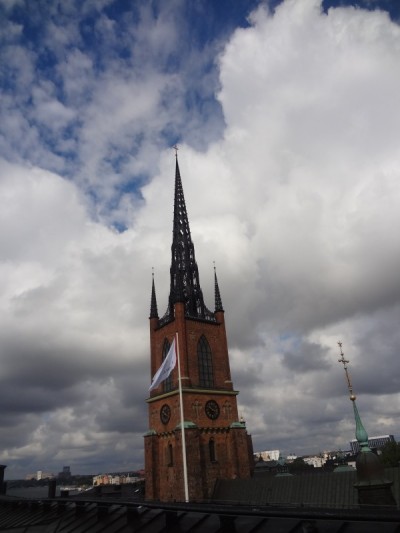
Eventually I
figured out the real purpose of the activity was to offer
spectacular views of the Stockholm landscape. With
that in mind, I took full advantage of the stunning views.
|
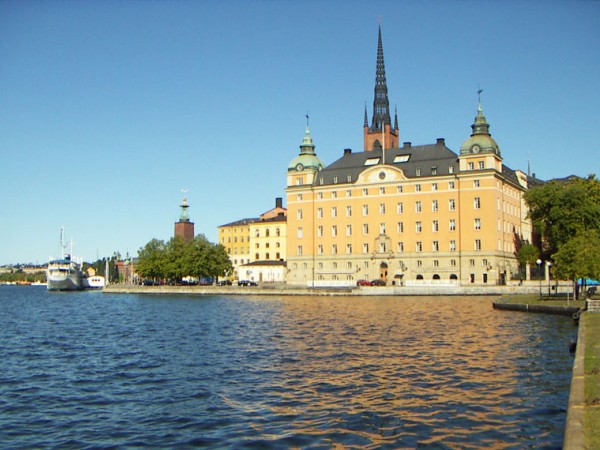
In this
picture you can see the "Kommerskollegium" building.
This is where the National Board of Trade and Commerce has
its headquarters. This was the building upon whose
roof we walked. We could actually see people working
in the offices below from our rooftop vantage point.
|
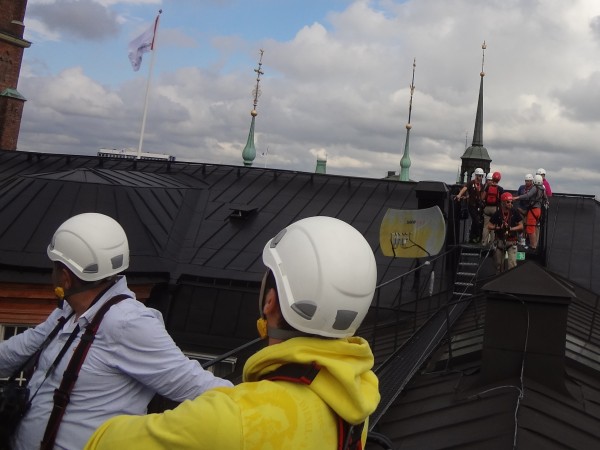
In this
picture you can see the hole in the roof. Eva took us
up to an attic at the top of the building. Then we
came out through a door where those people are standing.
They have just begun to figure out how the cable system
works.
|
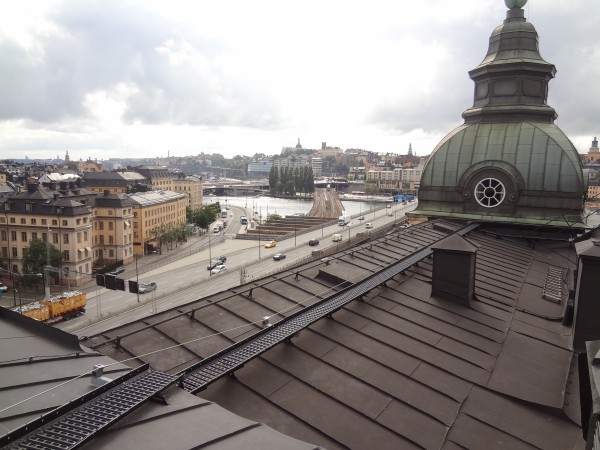
Some views of
the city. That is
Riddarfjärden Bay. Our ship is just to the left about
two miles away, but
out of sight behind those buildings.
|
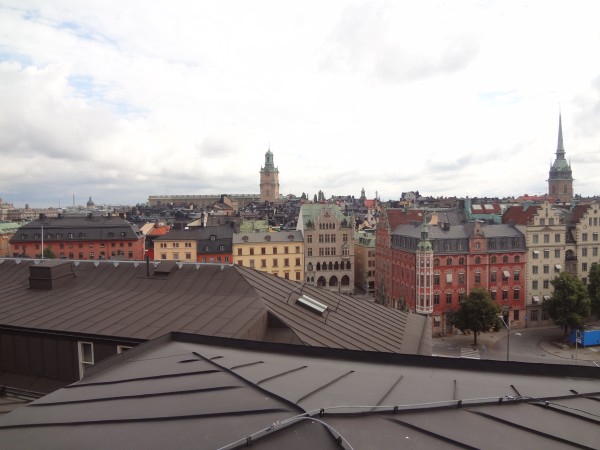
On the right
is a tall church steeple. Later you will see a picture
of an old German church in Gamla Stan - that will be the
same place.
|
| |
|
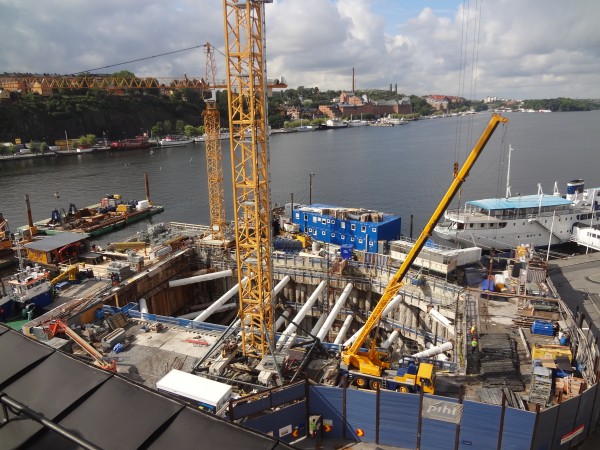 |
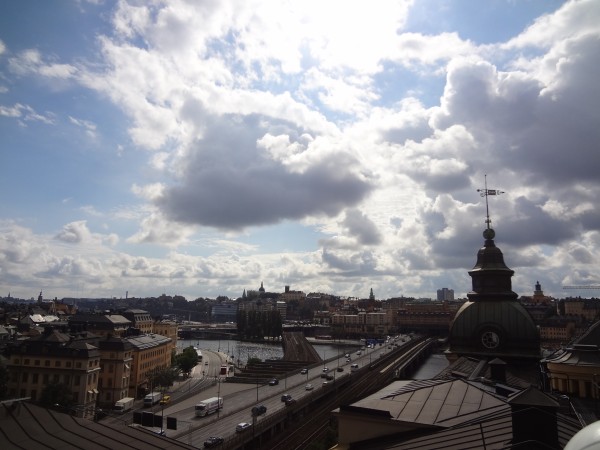 |
This was a tunnel for a train to go under the river.
|
The ship is
still hiding. Those buildings to the left are "Gamla
Stan".
|
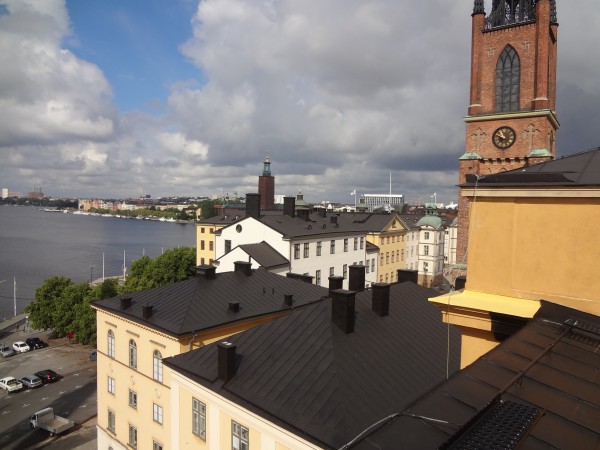 |
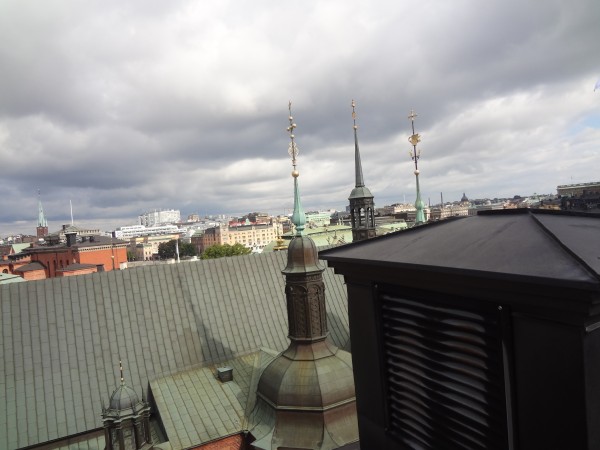 |
Now if they
wanted this event to be ultra-cool, we would zip line to
those other roof tops. Nah. No such luck.
At least the views are nice.
|
|

My final
disappointment was the discovery that our roof walk was
nothing more glamorous than a walk around this giant
rectangle. Our starting point had been in the upper
left hand corner of this picture. We would now walk
back on the left hand roof to return to the starting point.
This building was city property, by the way. The joke
was that if we fell, what good would it do to sue city hall?
|
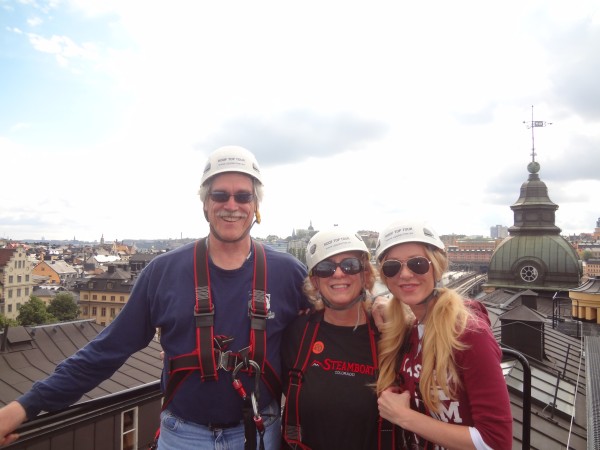
As it turned
out, the adventure was pretty tame. Still, the three
of us do deserve marks for courage. The writeup made
it seem a lot more risky than it turned out to be.
Based on what we thought we were getting into, we definitely
deserve the "Macho Man Merit Badge".
The adventure wasn't
all bad. Based on Eva's great stories plus the great
views, I'll give it a C+. However, they should not
have hyped it so much.
|
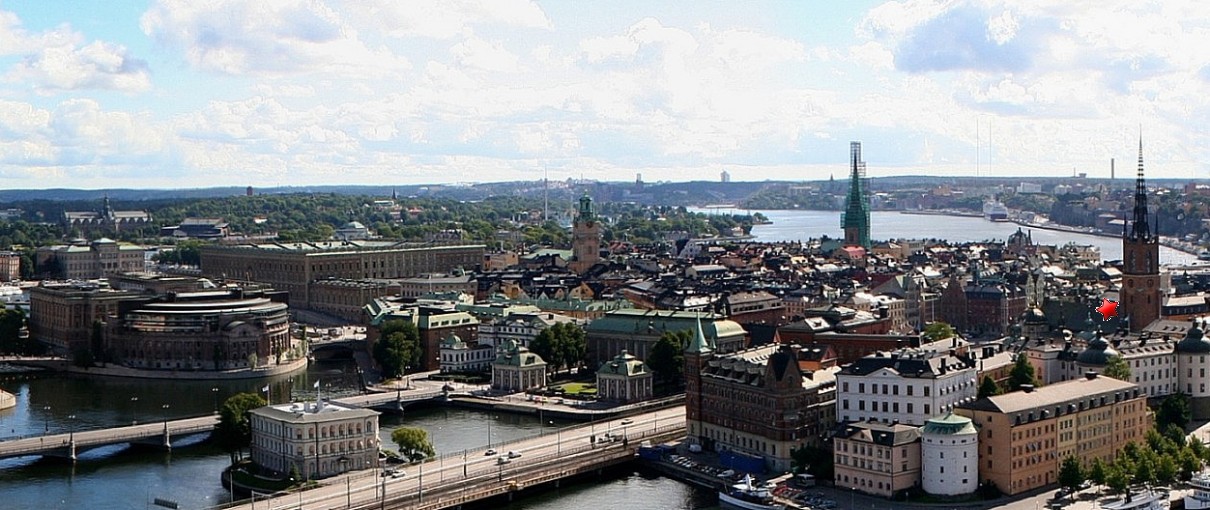 |
We are about
to visit Gamla Stan, Stockholm's "Old City". The red star
marks our roof walk building and now you can see the cruise ship in
the distance. This picture shows the major freeway that
separates Gamla Stan from the government buildings. In
the center right of the picture is a spire with scaffolding.
That is the old German church we will pass during our walk through
Gamla Stan. The giant rectangular building on the center left
is the Royal Palace. In the center of the picture is the Clock
Tower. It was 11 am when we started our walk. We will eat
lunch close to the Clock Tower at 1 pm.
|
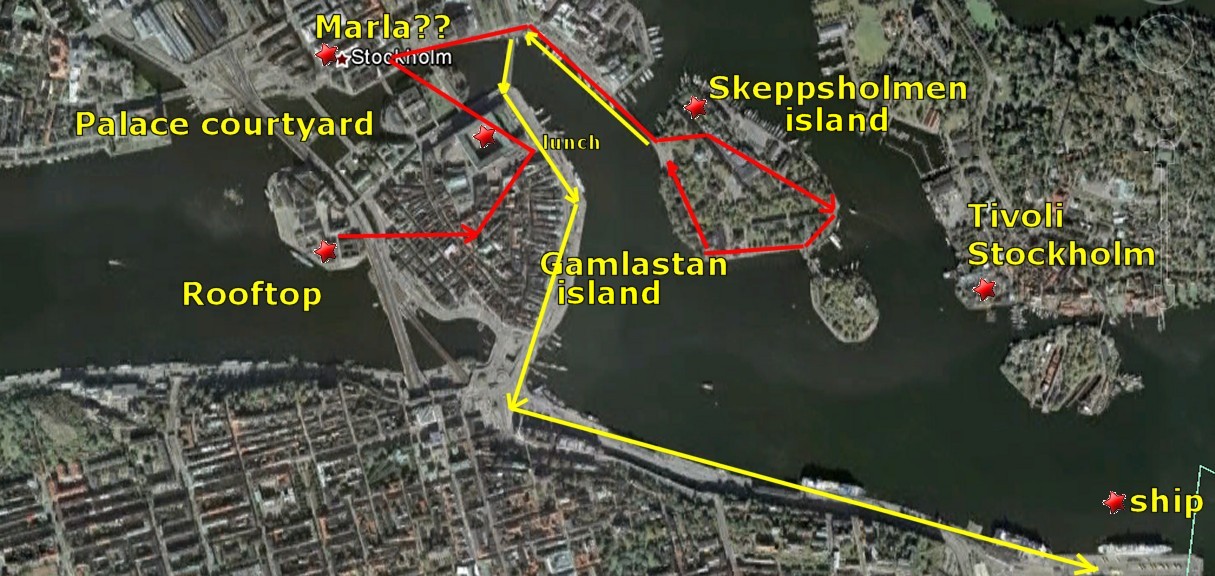 |
Gamla stan
Eva concluded her roof
walking about 11 am. She said the next stop would be a tour
through nearby Gamlastan, the oldest part of Stockholm.
Gamla stan is located on an island right in the middle of
Riddarfjärden Bay that runs through the center of Stockholm.
Eva explained that Gamla Stan is one of the best preserved medieval
city centers in Europe. This
is where Stockholm was founded in 1252.
Today it serves as one of the foremost attractions
in Stockholm.
Gamla Stan is a
pedestrian-friendly village of full of sights
from another era. Besides the fascinating architecture, there restaurants, cafés
and bars. If you are looking for a
place to shop, Gamla Stan
is similar to our own Renaissance Festival
because it has many shops full of handicrafts,
curios and souvenirs.
Stockholm became a modern, technologically advanced, and ethnically
diverse city in the latter half of the 20th century.
|
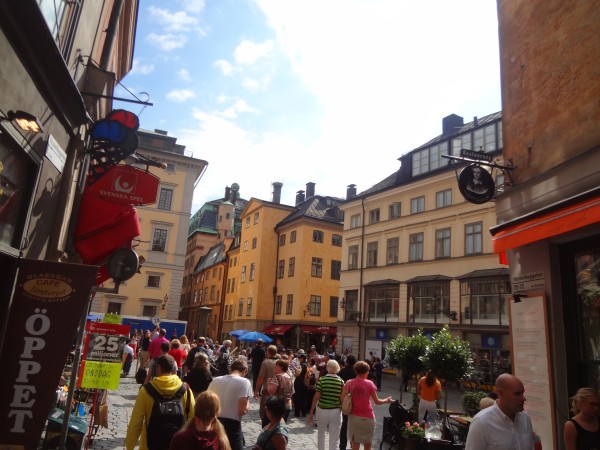 |
|
Many historical buildings were torn down during the modernist era
around 1930-1935 including substantial parts of the historical
district of Klara. These buildings were replaced with modern
architecture.
However, in parts of the city such as in Gamla Stan, many "old"
buildings, blocks and streets survived this era of demolition thanks
to a strong effort to preserve some of the past.
Thanks to being isolated on its own island, no one could bear to
level this charming neighborhood. Why not just keep it the way
it is?
As it turned out, Gamlastan was right across the freeway from our
rooftop adventure. We simply crossed the highway and there we
were.
|
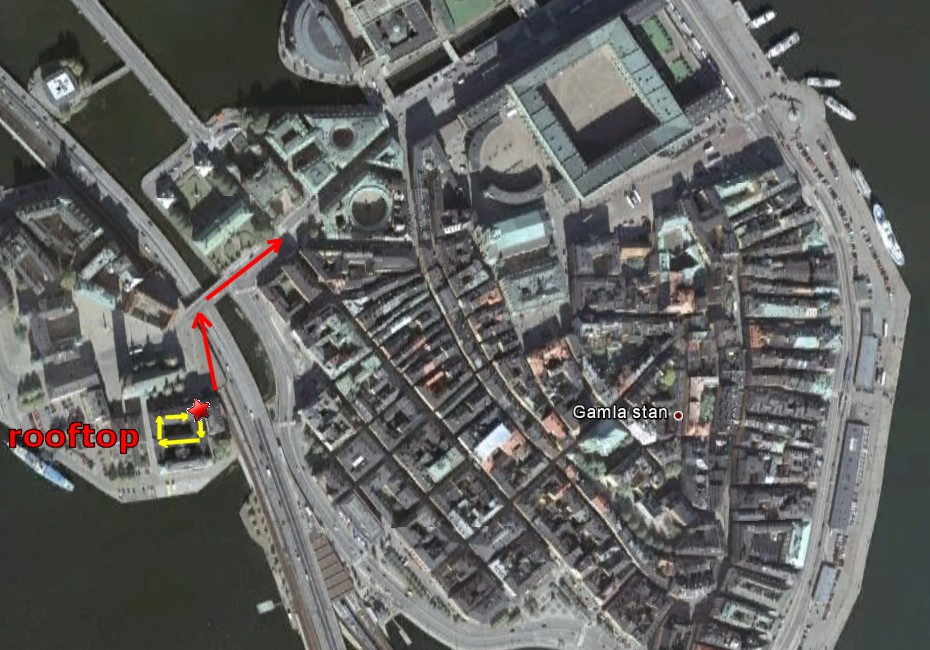 |
|
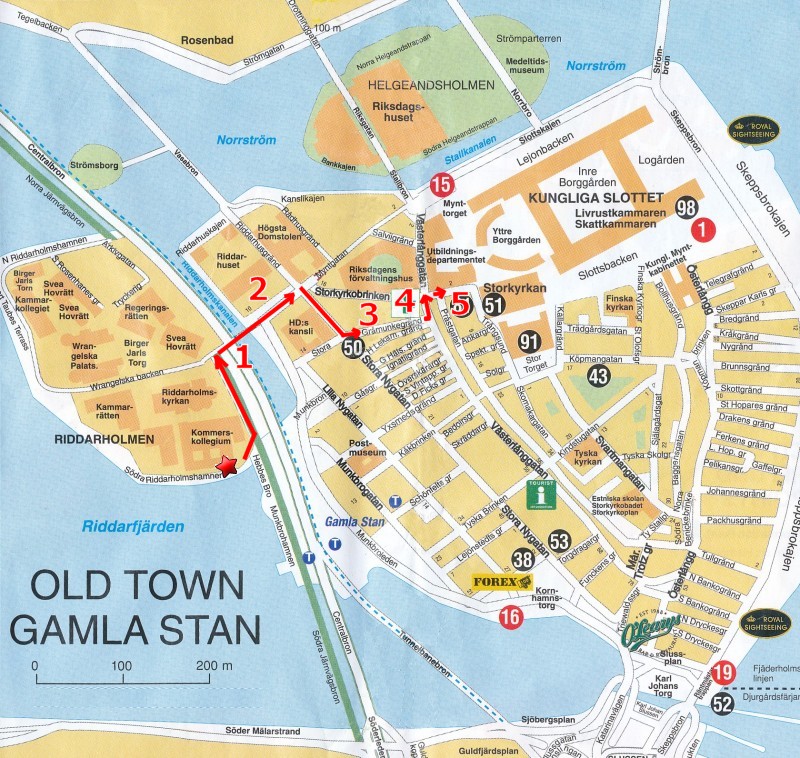 |
So now I am going to take you on a walk through Gamlastan.
First we had to cross a major freeway.
Eva grumbled the whole time. "We should have put this freeway
under water. We had to destroy many fine buildings!!"
I thought to myself Eva would never survive long in Houston with
that kind of attitude.
If there is a forest or a building in the way, no one in Houston ever hesitates to knock it down if it means another chance to
widen a precious freeway. I call Houston the "Concrete
Jungle".
You aren't going to disagree with me, are you?
Oddly enough, all the many freeways of Houston never bothered me
till I began to travel. That's when I discovered stunning
European cities such as Barcelona, Rome, Paris, and now Stockholm.
These cities do their best to preserve much of the past as well as
create a city structure that lives in harmony with their
environment.
Houston is too flat to ever be a truly stunning city, but we do grow
trees in abundance that we could take better advantage of. At
the very least, I think we need a long river walk along Buffalo
Bayou.
Plus we need to wide the Bayou so a cruise ship can dock downtown.
What a good idea!
|
|
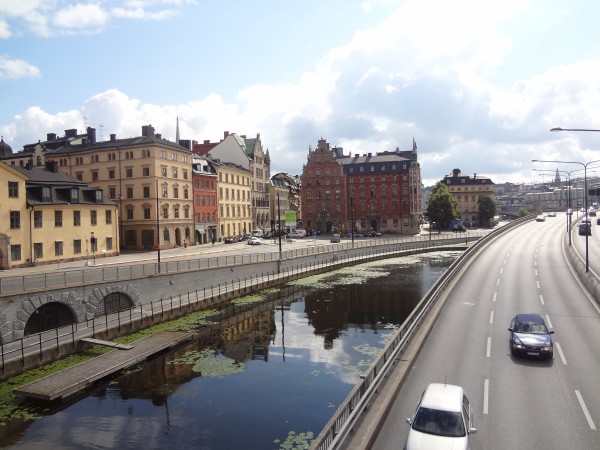
Using the map
above, you can trace our path. I have put numbers next
to various landmarks. For example, #1 shows the spot
where we crossed
the Freeway from our Rooftop walk into Gamlastan.
|
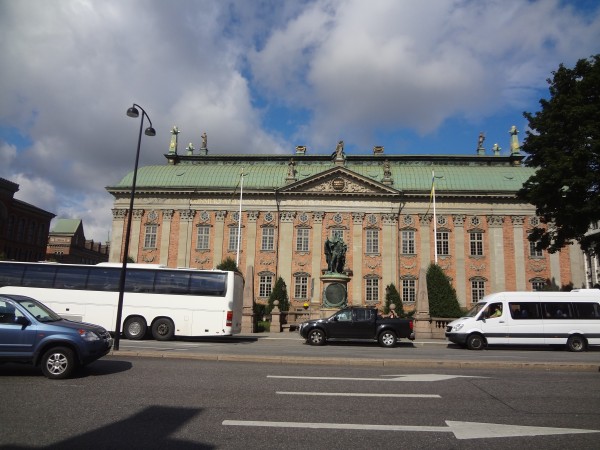
#2:
Riddarhuset - House of Nobility... where the nobles
used to meet. I think it is a tourist attraction
now.
|
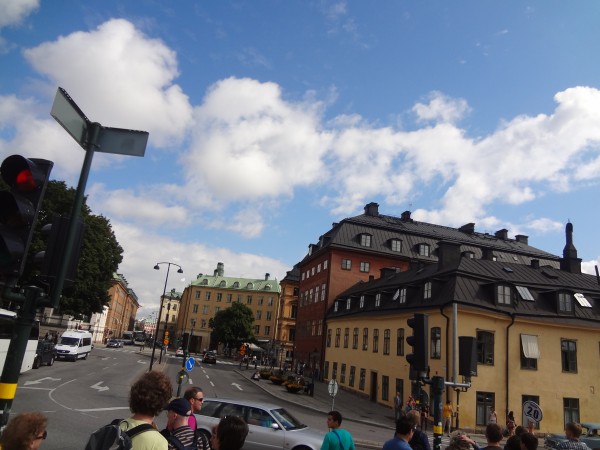
We are about
to enter Gamla Stan. These would be the last cars we
would see for the next hour and a half.
|
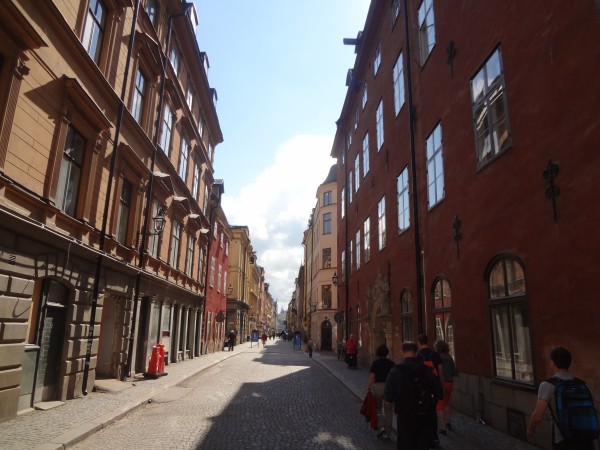
As we walked
down a series of narrow streets with four story buildings,
it was easy to feel like a mouse in a giant maze.
|
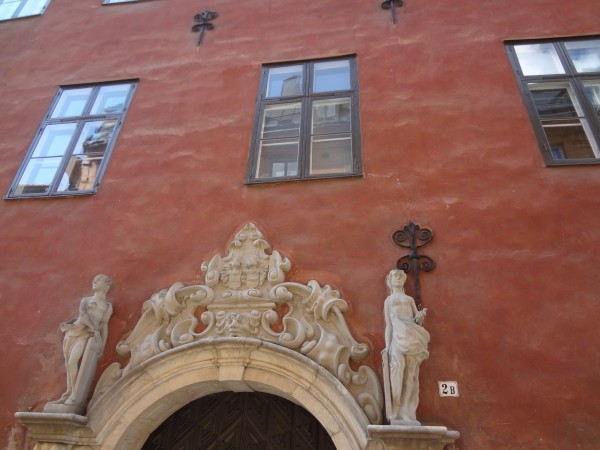 |
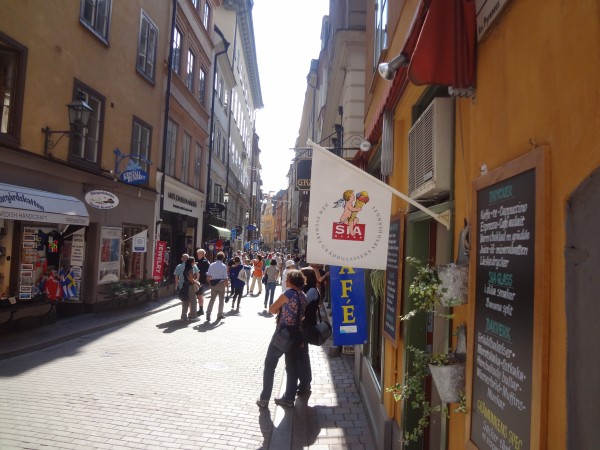 |
| |
|
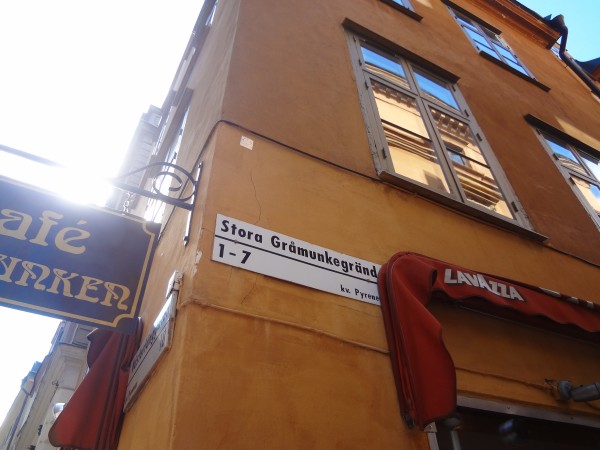
#3: Stora
Gramunkegrand Street
|
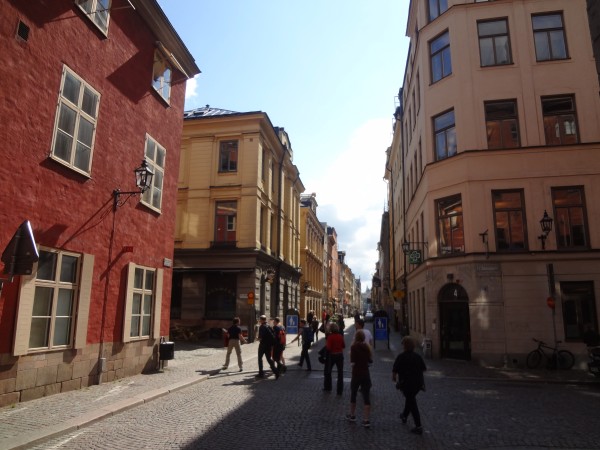
That's Jan and
Melissa walking in front of me.
|
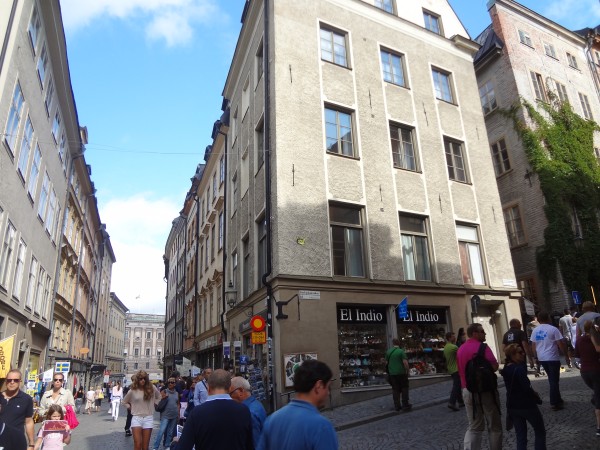 |
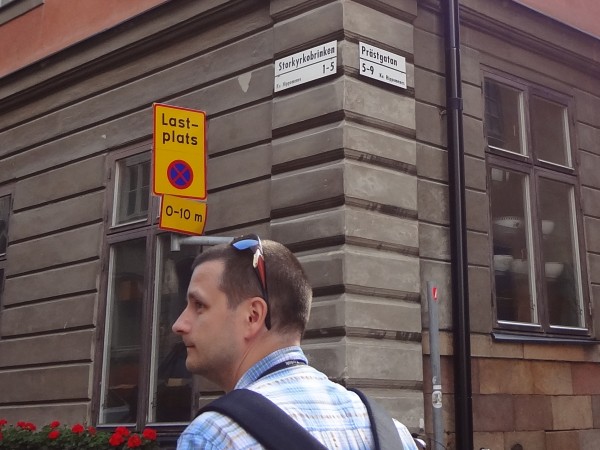 |
I never had any idea where we were. I wish I had a map to
keep track of our wanderings. It was only after the
fact that I retraced our route.
|
Aha! A solid landmark. Corner of Prasgatan and Storkyrkobrinken.
This spot is #4 and #5 in the map below. We are headed
to the red star.
|
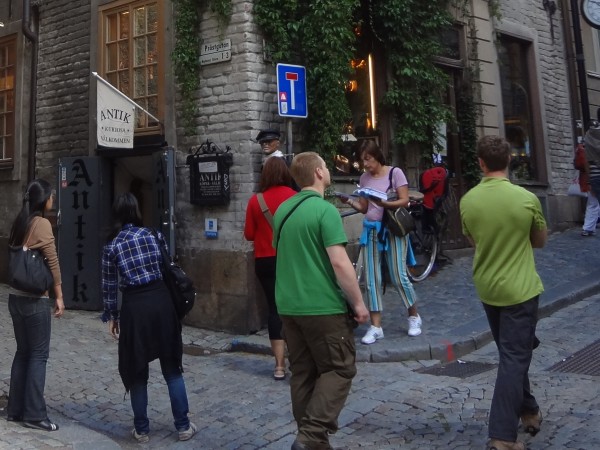
So where are
we? For starters, we are clearly on #5 Prasgatan.
Eva is heading for the edge of the Royal Palace (red
star).
From there she will head to the Clock Tower (51) and the
German Church.
|
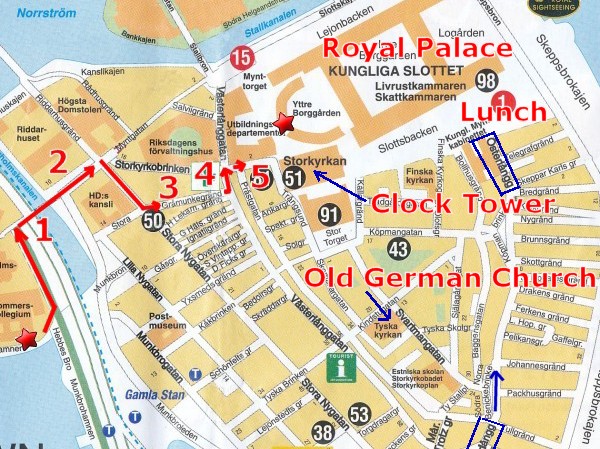
From there she
will head south to the bottom of the picture to a long
street known as Osterlangg. At the end of our walk, we
will travel the length of Osterlangg back towards the Royal
Palace and have lunch.
|
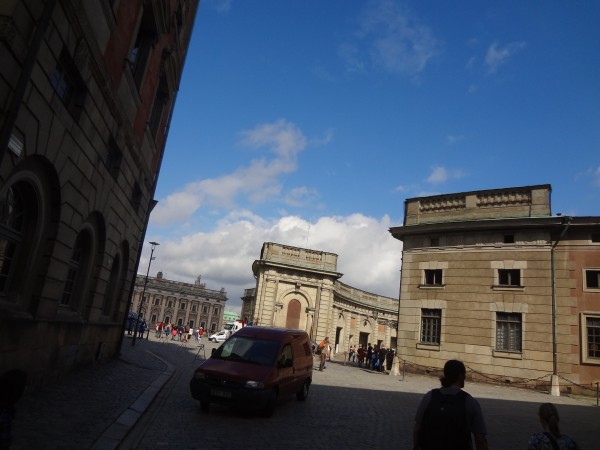
#6: Front edge of
the Royal Palace. Now we turned to the right.
|
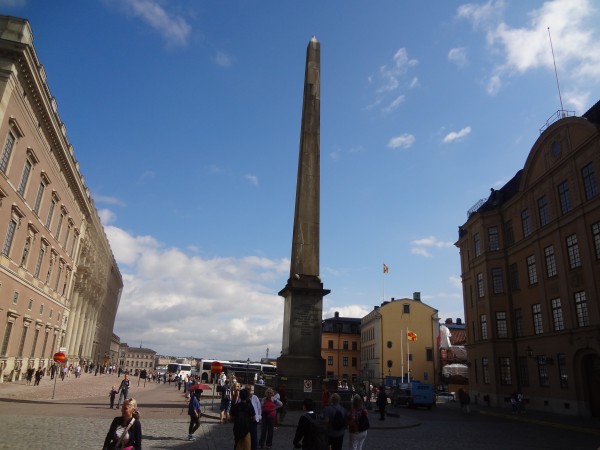
#7:
Slottsbacken Square next to the Royal Palace. This is
a major drop off point for tour
buses
|
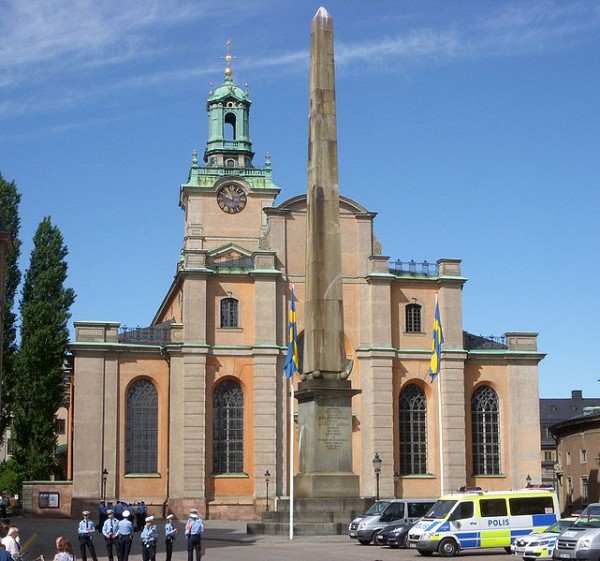 |
We passed
Storkyrkan Cathedral. Finally I saw the building
attached to the Clock Tower I had been noticing all morning.
This church
has three names. It is most commonly known as
Storkyrkan (The Great Church), but is also called the
Church of St. Nicholas and the Stockholm Cathedral.
Storkyrkan
Cathedral is the oldest church in Gamla Stan. It is an
important example of Swedish Brick Gothic.
Situated next
to the Royal Palace, it forms the western end of
Slottsbacken, the major approach to the Royal Palace, while
the street of Storkyrkobrinken passes north of it.
Just south of
the church is the Stockholm Stock Exchange Building which
faces the Stortorget Square. This building contains
the Swedish Academy, Nobel Library, and Nobel Museum.
We were about
to pass both the Square and the Nobel Museum
|
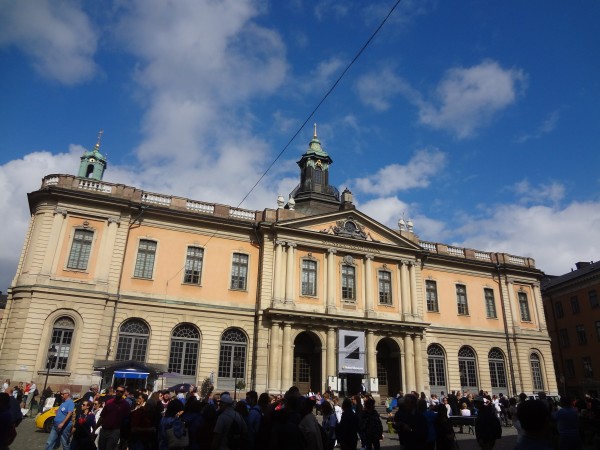 |
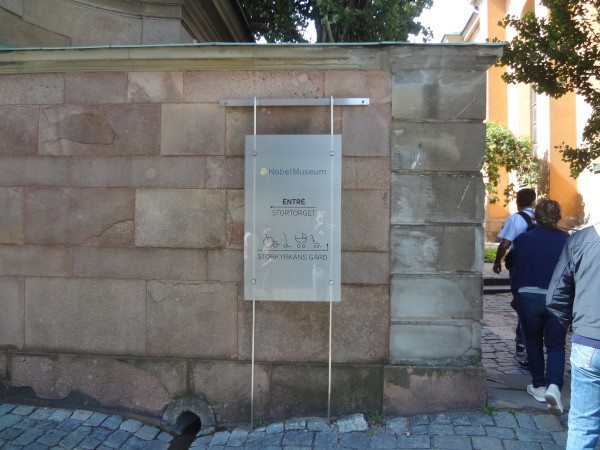 |
#8: Nobel Museum in Stortorget Square next to the Storkyrkan
Cathedral. The Nobel Museum is devoted to circulate
information on the Nobel Prize and the various Nobel
laureates from 1901 to present
The Nobel
Prize takes its name from the founder of the prize, Alfred
Nobel (1833-1896). Alfred Nobel was a Swedish chemist,
engineer, innovator, and armaments manufacturer. He was the
inventor of dynamite. Nobel held 350 different patents,
dynamite being the most famous. He used his fortune to
posthumously institute the Nobel Prizes.
The museum opened in the spring of 2001 for the centenary of
the Nobel Prize. The museum boasts exhibitions featuring
celebrities such as Marie Curie, Nelson Mandela, and Winston
Churchill, to name but a few.
Since its opening, the great demand for guided tours from
school classes have made the premises in the old town
cramped for space. Current ambitions are to relocate
the institution to a more suitable building on Skeppsholmen,
the islet further east in central Stockholm already home to
other museums.
Skeppsholmen is the island that Jan, Melissa and I would
visit in the afternoon.
|
 |
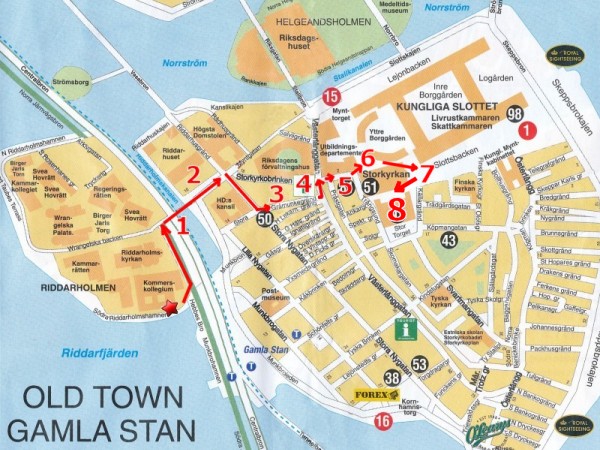 |
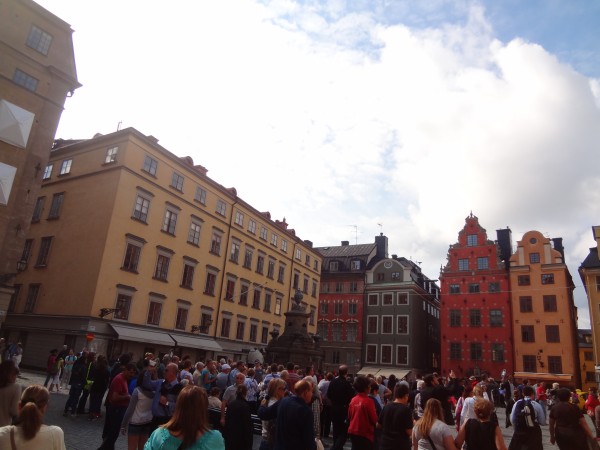
Stortorget Square
was very crowded. It would have been fun to stop and
have a beer or some wine and watch the tourists go by.
|
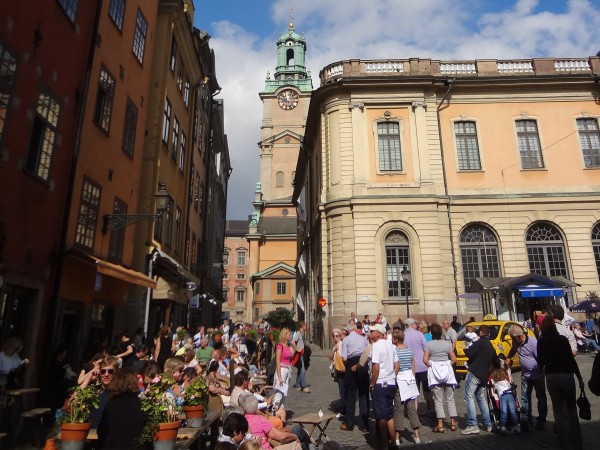
Row of Cafes
at the edge of Stortorget Square with the Clock Tower of Storkyrkan
Cathedral in the background. That's the Nobel Museum.
|
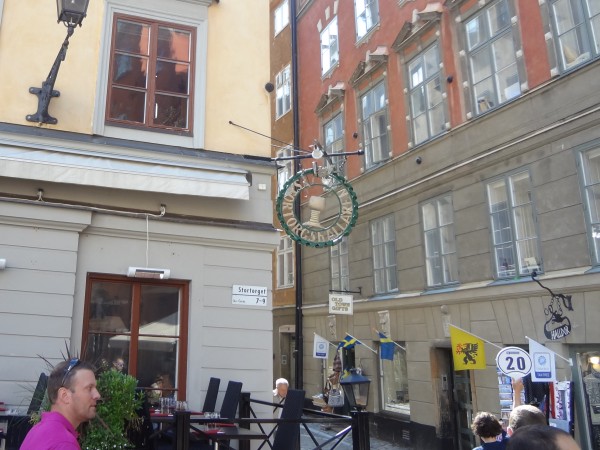
#9: Stortorget
|
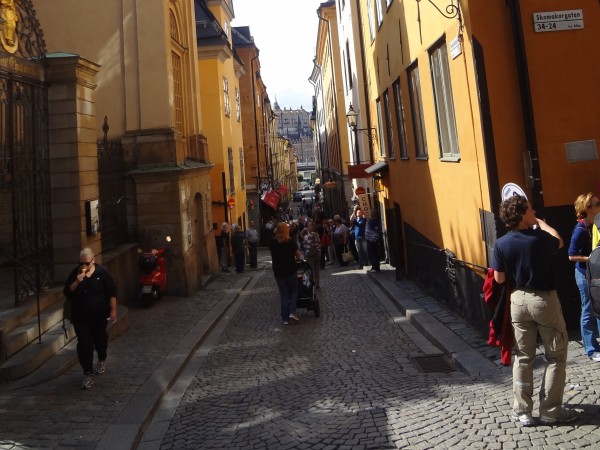
#10:
Skomakargatan. You should try typing some of these.
Spellcheck is going nuts!
|
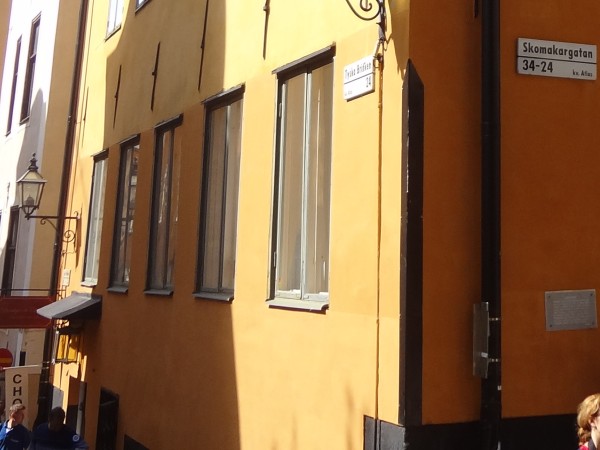
Skomakargatan
and Tyska Brinken
|
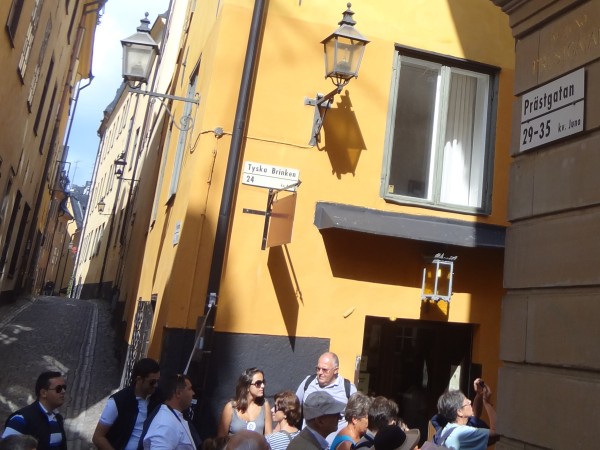
#11: Tyska
Brinken and Prasgatan - see below
|
|